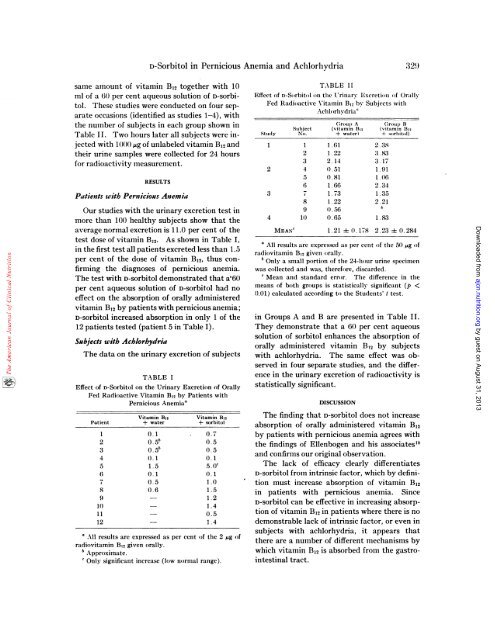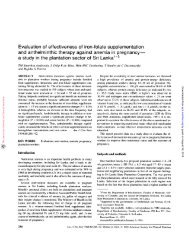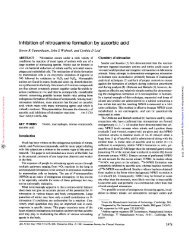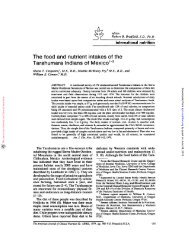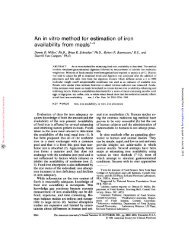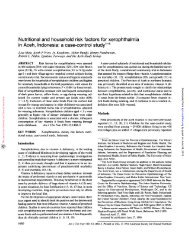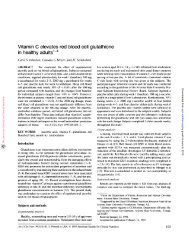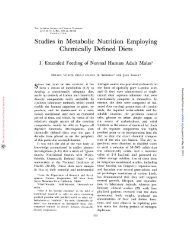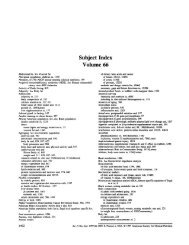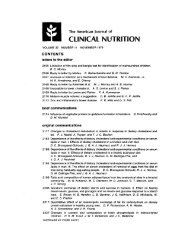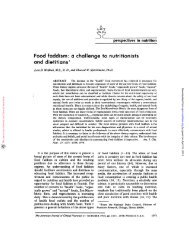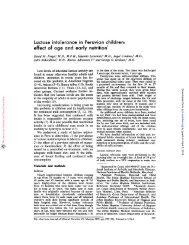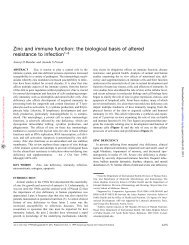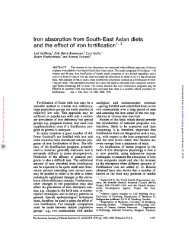Influence of D-Sorbitol on Absorption of Vitamin B12 by Patients with ...
Influence of D-Sorbitol on Absorption of Vitamin B12 by Patients with ...
Influence of D-Sorbitol on Absorption of Vitamin B12 by Patients with ...
You also want an ePaper? Increase the reach of your titles
YUMPU automatically turns print PDFs into web optimized ePapers that Google loves.
D-<str<strong>on</strong>g>Sorbitol</str<strong>on</strong>g> in Pernicious Anemia and Achlorhydria 329<br />
same amount <str<strong>on</strong>g>of</str<strong>on</strong>g> vitamin B,2 together <strong>with</strong> 10<br />
ml <str<strong>on</strong>g>of</str<strong>on</strong>g> a (jo per cent aqueous soluti<strong>on</strong> <str<strong>on</strong>g>of</str<strong>on</strong>g> D-sorbitol.<br />
These studies were c<strong>on</strong>ducted <strong>on</strong> four separate<br />
occasi<strong>on</strong>s (identified as studies 1-4), <strong>with</strong><br />
the number <str<strong>on</strong>g>of</str<strong>on</strong>g> subjects in each group shown in<br />
Table II. Two hours later all subjects were injected<br />
<strong>with</strong> 1000 jg <str<strong>on</strong>g>of</str<strong>on</strong>g> unlabeled vitamin B,2 and<br />
their urine samples were collected for 24 hours<br />
for radioactivity measurement.<br />
‘I All results are expressed as per cent <str<strong>on</strong>g>of</str<strong>on</strong>g> the 2 pg <str<strong>on</strong>g>of</str<strong>on</strong>g><br />
radiovitamin B,, given orally.<br />
6 Approximate.<br />
RESULTS<br />
<strong>Patients</strong> <strong>with</strong> Pernicious Anemia<br />
Our studies <strong>with</strong> the urinary excreti<strong>on</strong> test in<br />
more than 100 healthy subjects show that the<br />
average normal excreti<strong>on</strong> is 1 1 .0 per cent <str<strong>on</strong>g>of</str<strong>on</strong>g> the<br />
test dose <str<strong>on</strong>g>of</str<strong>on</strong>g> vitamin B,2. As shown in Table I,<br />
in the first test all patients excreted less than 1.5<br />
per cent <str<strong>on</strong>g>of</str<strong>on</strong>g> the dose <str<strong>on</strong>g>of</str<strong>on</strong>g> vitamin B,2, thus c<strong>on</strong>firming<br />
the diagnoses <str<strong>on</strong>g>of</str<strong>on</strong>g> pernicious anemia.<br />
The test <strong>with</strong> D-sorbitol dem<strong>on</strong>strated that a’60<br />
per cent aqueous soluti<strong>on</strong> <str<strong>on</strong>g>of</str<strong>on</strong>g> D-sorbitol had no<br />
effect <strong>on</strong> the absorpti<strong>on</strong> <str<strong>on</strong>g>of</str<strong>on</strong>g> orally administered<br />
vitamin B,2 <strong>by</strong> patients <strong>with</strong> pernicious anemia;<br />
D-sOrbitol increased absorpti<strong>on</strong> in <strong>on</strong>ly 1 <str<strong>on</strong>g>of</str<strong>on</strong>g> the<br />
12 patients tested (patient 5 in Table I).<br />
Subjects <strong>with</strong> Achiorhydria<br />
The data <strong>on</strong> the urinary excreti<strong>on</strong> <str<strong>on</strong>g>of</str<strong>on</strong>g> subjects<br />
TABLE<br />
Effect <str<strong>on</strong>g>of</str<strong>on</strong>g> D-<str<strong>on</strong>g>Sorbitol</str<strong>on</strong>g> <strong>on</strong> the Urinary Excreti<strong>on</strong> <str<strong>on</strong>g>of</str<strong>on</strong>g> Orally<br />
Fed RadioactiVe <strong>Vitamin</strong> B,, <strong>by</strong> <strong>Patients</strong> <strong>with</strong><br />
Patient<br />
1<br />
2<br />
3<br />
Pernicious<br />
C Only significant increase (low normal range).<br />
I<br />
Anemiaa<br />
<strong>Vitamin</strong> <strong>B12</strong><br />
+ water<br />
0.1<br />
05b<br />
05b<br />
<strong>Vitamin</strong> BI2<br />
+ sorbitol<br />
. 0.7<br />
0.5<br />
0.5<br />
4 0.1 0.1<br />
5 1.5 5.0c<br />
6 0.1 0.1<br />
7 0.5 1.0<br />
S 0.6 1.5<br />
9 - 1.2<br />
10 - 1.4<br />
11 - 0.5<br />
12 - 1.4<br />
TABLE<br />
Effect <str<strong>on</strong>g>of</str<strong>on</strong>g> D-<str<strong>on</strong>g>Sorbitol</str<strong>on</strong>g> <strong>on</strong> the l.ninary Excreti<strong>on</strong> <str<strong>on</strong>g>of</str<strong>on</strong>g> Orally<br />
Fed Radioactive \‘ita1nin B,, <strong>by</strong> Subjects <strong>with</strong><br />
Study<br />
Subject<br />
No.<br />
Achlorhvdnia”<br />
a All results are expressed as per cent <str<strong>on</strong>g>of</str<strong>on</strong>g> the 50 pg <str<strong>on</strong>g>of</str<strong>on</strong>g><br />
radiovitamin B,, given orally.<br />
b Only a small porti<strong>on</strong> <str<strong>on</strong>g>of</str<strong>on</strong>g> the 24-hour urine specimen<br />
was collected and was, therefore, discarded.<br />
C Mean and standard error. The difference in the<br />
means <str<strong>on</strong>g>of</str<strong>on</strong>g> both groups is statistically significant (p <<br />
0.01) calculated according to the Students’ t test.<br />
II<br />
Group A<br />
(vitamin B,,<br />
+ water)<br />
1 1 1.61 2.38<br />
2 1.22 3.83<br />
3 2.14 3.17<br />
2 4 0.51 1.91<br />
3 7<br />
8<br />
5 0.81 1.06<br />
6 1.66 2.34<br />
9<br />
1.73<br />
1.22<br />
0.56<br />
Group B<br />
(vitamin 1312<br />
+ sorhitol)<br />
1.35<br />
2.21<br />
b<br />
4 10 0.65 1.83<br />
MEANC 1.21 ± 0.178 2.23 ± 0.284<br />
in Groups A and B are presented in Table II.<br />
They dem<strong>on</strong>strate that a 60 per cent aqueous<br />
soluti<strong>on</strong> <str<strong>on</strong>g>of</str<strong>on</strong>g> sorbitol enhances the absorpti<strong>on</strong> <str<strong>on</strong>g>of</str<strong>on</strong>g><br />
orally administered vitamin B,2 <strong>by</strong> subjects<br />
<strong>with</strong> achlorhydria. The same effect was observed<br />
in four separate studies, and the difference<br />
in the urinary excreti<strong>on</strong> <str<strong>on</strong>g>of</str<strong>on</strong>g> radioactivity is<br />
statistically<br />
significant.<br />
DISCUSSION<br />
The finding that D-sorbitOl does not increase<br />
absorpti<strong>on</strong> <str<strong>on</strong>g>of</str<strong>on</strong>g> orally administered vitamin B,2<br />
<strong>by</strong> patients <strong>with</strong> pernicious anemia agrees <strong>with</strong><br />
the findings <str<strong>on</strong>g>of</str<strong>on</strong>g> Ellenbogen and his associatestm#{176}<br />
and c<strong>on</strong>firms our original observati<strong>on</strong>.<br />
The lack <str<strong>on</strong>g>of</str<strong>on</strong>g> efficacy clearly differentiates<br />
D-sorbitol from intrinsic factor, which <strong>by</strong> definiti<strong>on</strong><br />
must increase absorpti<strong>on</strong> <str<strong>on</strong>g>of</str<strong>on</strong>g> vitamin B,2<br />
in patients <strong>with</strong> pernicious anemia. Since<br />
D-sorbitol can be effective in increasing absorpti<strong>on</strong><br />
<str<strong>on</strong>g>of</str<strong>on</strong>g> vitamin B,, in patients where there is no<br />
dem<strong>on</strong>strable lack <str<strong>on</strong>g>of</str<strong>on</strong>g> intrinsic factor, or even in<br />
subjects <strong>with</strong> achlorhydria, it appears that<br />
there are a number <str<strong>on</strong>g>of</str<strong>on</strong>g> different mechanisms <strong>by</strong><br />
which vitamin B,, is absorbed from the gastrointestinal<br />
tract.<br />
Downloaded from ajcn.nutriti<strong>on</strong>.org <strong>by</strong> guest <strong>on</strong> August 31, 2013


